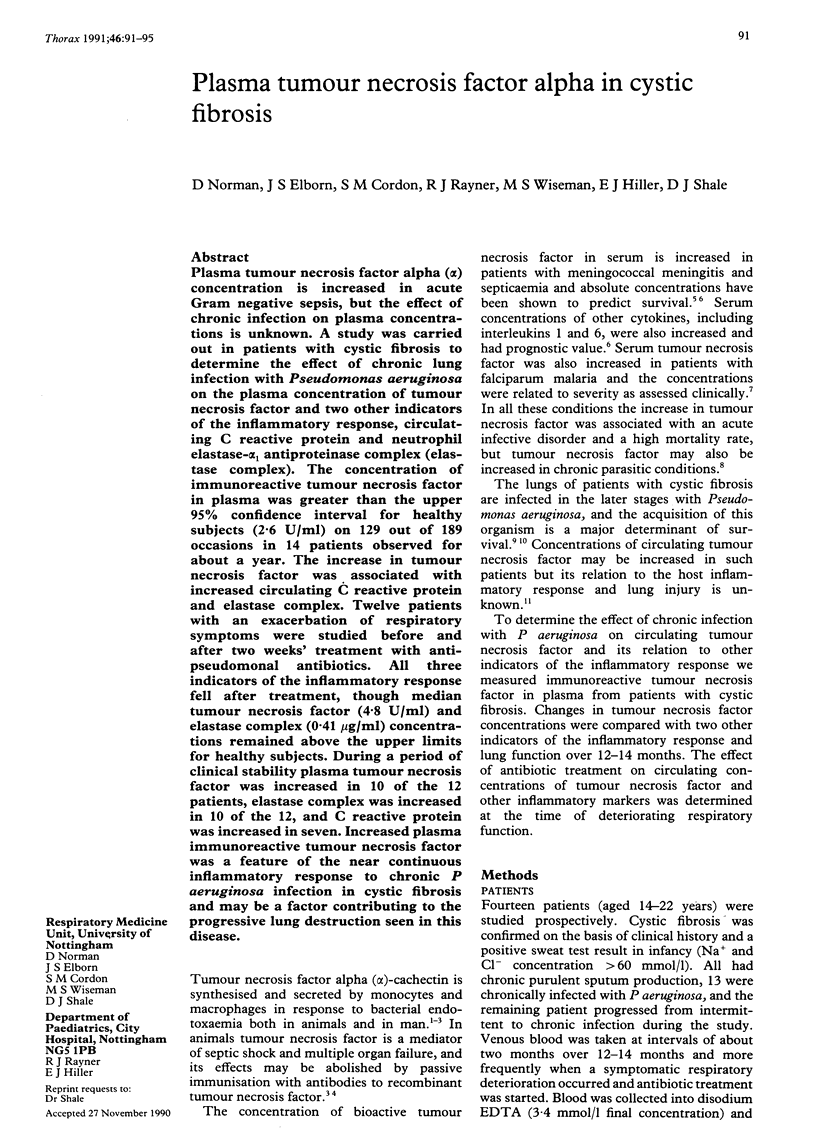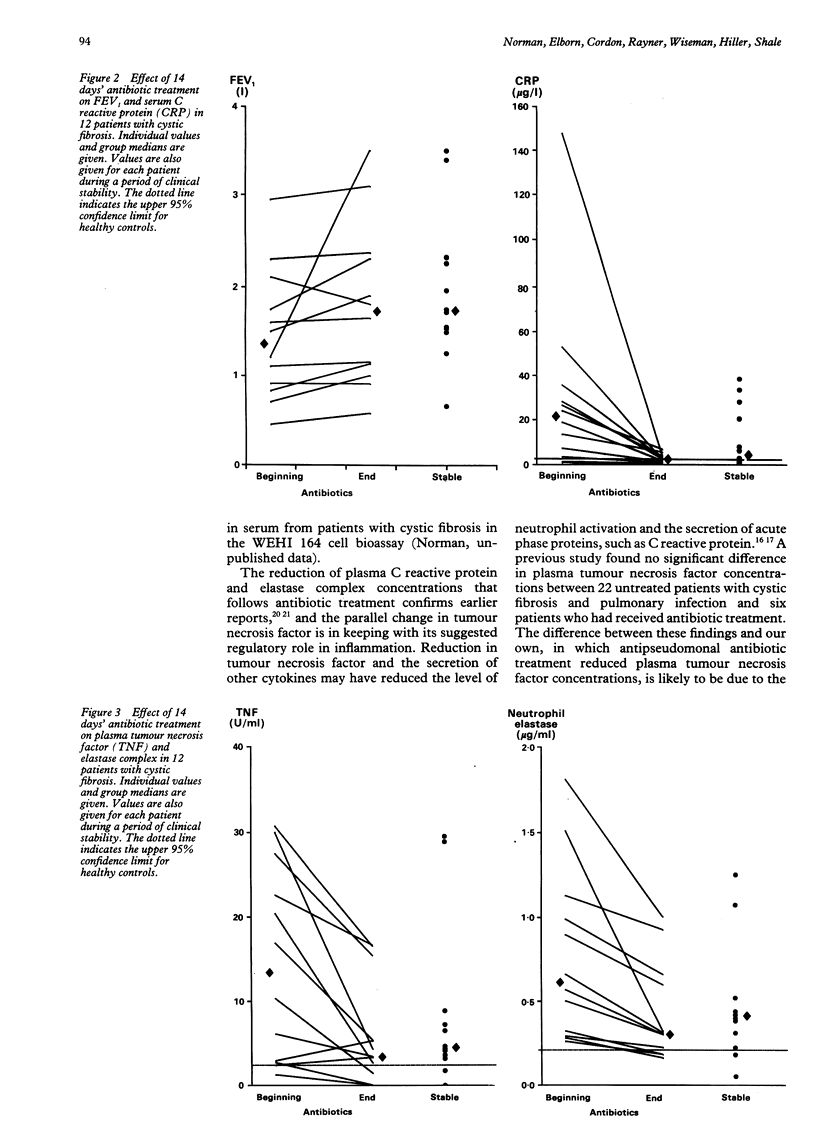Abstract
Plasma tumour necrosis factor alpha (alpha) concentration is increased in acute Gram negative sepsis, but the effect of chronic infection on plasma concentrations is unknown. A study was carried out in patients with cystic fibrosis to determine the effect of chronic lung infection with Pseudomonas aeruginosa on the plasma concentration of tumour necrosis factor and two other indicators of the inflammatory response, circulating C reactive protein and neutrophil elastase-alpha 1 antiproteinase complex (elastase complex). The concentration of immunoreactive tumour necrosis factor in plasma was greater than the upper 95% confidence interval for healthy subjects (2.6 U/ml) on 129 out of 189 occasions in 14 patients observed for about a year. The increase in tumour necrosis factor was associated with increased circulating C reactive protein and elastase complex. Twelve patients with an exacerbation of respiratory symptoms were studied before and after two weeks' treatment with anti-pseudomonal antibiotics. All three indicators of the inflammatory response fell after treatment, though median tumour necrosis factor (4.8 U/ml) and elastase complex (0.41 microgram/ml) concentrations remained above the upper limits for healthy subjects. During a period of clinical stability plasma tumour necrosis factor was increased in 10 of the 12 patients, elastase complex was increased in 10 of the 12, and C reactive protein was increased in seven. Increased plasma immunoreactive tumour necrosis factor was a feature of the near continuous inflammatory response to chronic P aeruginosa infection in cystic fibrosis and may be a factor contributing to the progressive lung destruction seen in this disease.
Full text
PDF




Selected References
These references are in PubMed. This may not be the complete list of references from this article.
- Auerbach H. S., Williams M., Kirkpatrick J. A., Colten H. R. Alternate-day prednisone reduces morbidity and improves pulmonary function in cystic fibrosis. Lancet. 1985 Sep 28;2(8457):686–688. doi: 10.1016/s0140-6736(85)92929-0. [DOI] [PubMed] [Google Scholar]
- Beutler B., Milsark I. W., Cerami A. C. Passive immunization against cachectin/tumor necrosis factor protects mice from lethal effect of endotoxin. Science. 1985 Aug 30;229(4716):869–871. doi: 10.1126/science.3895437. [DOI] [PubMed] [Google Scholar]
- Billingham M. E. Cytokines as inflammatory mediators. Br Med Bull. 1987 Apr;43(2):350–370. doi: 10.1093/oxfordjournals.bmb.a072187. [DOI] [PubMed] [Google Scholar]
- Bruce M. C., Poncz L., Klinger J. D., Stern R. C., Tomashefski J. F., Jr, Dearborn D. G. Biochemical and pathologic evidence for proteolytic destruction of lung connective tissue in cystic fibrosis. Am Rev Respir Dis. 1985 Sep;132(3):529–535. doi: 10.1164/arrd.1985.132.3.529. [DOI] [PubMed] [Google Scholar]
- Crozier D. N. Cystic fibrosis: a not-so-fatal disease. Pediatr Clin North Am. 1974 Nov;21(4):935–950. doi: 10.1016/s0031-3955(16)33069-3. [DOI] [PubMed] [Google Scholar]
- Grau G. E., Taylor T. E., Molyneux M. E., Wirima J. J., Vassalli P., Hommel M., Lambert P. H. Tumor necrosis factor and disease severity in children with falciparum malaria. N Engl J Med. 1989 Jun 15;320(24):1586–1591. doi: 10.1056/NEJM198906153202404. [DOI] [PubMed] [Google Scholar]
- Hesse D. G., Tracey K. J., Fong Y., Manogue K. R., Palladino M. A., Jr, Cerami A., Shires G. T., Lowry S. F. Cytokine appearance in human endotoxemia and primate bacteremia. Surg Gynecol Obstet. 1988 Feb;166(2):147–153. [PubMed] [Google Scholar]
- Hollsing A. E., Lantz B., Bergström K., Malmborg A. S., Strandvik B. Granulocyte elastase-alpha 1-antiproteinase complex in cystic fibrosis: sensitive plasma assay for monitoring pulmonary infections. J Pediatr. 1987 Aug;111(2):206–211. doi: 10.1016/s0022-3476(87)80068-9. [DOI] [PubMed] [Google Scholar]
- Høiby N., Döring G., Schiøtz P. O. The role of immune complexes in the pathogenesis of bacterial infections. Annu Rev Microbiol. 1986;40:29–53. doi: 10.1146/annurev.mi.40.100186.000333. [DOI] [PubMed] [Google Scholar]
- Konstan M. W., Vargo K. M., Davis P. B. Ibuprofen attenuates the inflammatory response to Pseudomonas aeruginosa in a rat model of chronic pulmonary infection. Implications for antiinflammatory therapy in cystic fibrosis. Am Rev Respir Dis. 1990 Jan;141(1):186–192. doi: 10.1164/ajrccm/141.1.186. [DOI] [PubMed] [Google Scholar]
- Kovacs J. A., Gill V., Swan J. C., Ognibene F., Shelhamer J., Parrillo J. E., Masur H. Prospective evaluation of a monoclonal antibody in diagnosis of Pneumocystis carinii pneumonia. Lancet. 1986 Jul 5;2(8497):1–3. doi: 10.1016/s0140-6736(86)92555-9. [DOI] [PubMed] [Google Scholar]
- Michie H. R., Manogue K. R., Spriggs D. R., Revhaug A., O'Dwyer S., Dinarello C. A., Cerami A., Wolff S. M., Wilmore D. W. Detection of circulating tumor necrosis factor after endotoxin administration. N Engl J Med. 1988 Jun 9;318(23):1481–1486. doi: 10.1056/NEJM198806093182301. [DOI] [PubMed] [Google Scholar]
- Pier G. B. Pulmonary disease associated with Pseudomonas aeruginosa in cystic fibrosis: current status of the host-bacterium interaction. J Infect Dis. 1985 Apr;151(4):575–580. doi: 10.1093/infdis/151.4.575. [DOI] [PubMed] [Google Scholar]
- Rocker G. M., Wiseman M. S., Pearson D., Shale D. J. Diagnostic criteria for adult respiratory distress syndrome: time for reappraisal. Lancet. 1989 Jan 21;1(8630):120–123. doi: 10.1016/s0140-6736(89)91142-2. [DOI] [PubMed] [Google Scholar]
- Salonen E. M. A rapid and sensitive solid-phase enzyme immunoassay for C-reactive protein. J Immunol Methods. 1982;48(1):45–50. doi: 10.1016/0022-1759(82)90208-3. [DOI] [PubMed] [Google Scholar]
- Suter S., Schaad U. B., Roux-Lombard P., Girardin E., Grau G., Dayer J. M. Relation between tumor necrosis factor-alpha and granulocyte elastase-alpha 1-proteinase inhibitor complexes in the plasma of patients with cystic fibrosis. Am Rev Respir Dis. 1989 Dec;140(6):1640–1644. doi: 10.1164/ajrccm/140.6.1640. [DOI] [PubMed] [Google Scholar]
- Tracey K. J., Fong Y., Hesse D. G., Manogue K. R., Lee A. T., Kuo G. C., Lowry S. F., Cerami A. Anti-cachectin/TNF monoclonal antibodies prevent septic shock during lethal bacteraemia. Nature. 1987 Dec 17;330(6149):662–664. doi: 10.1038/330662a0. [DOI] [PubMed] [Google Scholar]
- Waage A., Brandtzaeg P., Halstensen A., Kierulf P., Espevik T. The complex pattern of cytokines in serum from patients with meningococcal septic shock. Association between interleukin 6, interleukin 1, and fatal outcome. J Exp Med. 1989 Jan 1;169(1):333–338. doi: 10.1084/jem.169.1.333. [DOI] [PMC free article] [PubMed] [Google Scholar]
- Waage A., Halstensen A., Espevik T. Association between tumour necrosis factor in serum and fatal outcome in patients with meningococcal disease. Lancet. 1987 Feb 14;1(8529):355–357. doi: 10.1016/s0140-6736(87)91728-4. [DOI] [PubMed] [Google Scholar]


